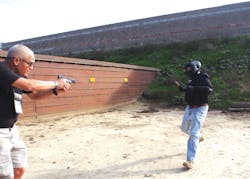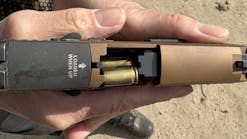What the 21-foot Rule IS, and What it is NOT
Officers vs suspect encounters are dynamic and fluid situations.When it comes to law enforcement officers encountering suspects with edged or blunt trauma weapons, there isn't really a hard and fast rule when it comes to stand off distance.
The 21 foot rule is a phrase that was coined after Lt. Dennis Tueller (Ret.) first shared his studies about defending against edged or blunt trauma weapons in the article How CLOSE is TOO CLOSE? Published in the March 1983 issue of SWAT magazine. Tueller proposed to the reader that there was a point in time when close was too close to be able to respond and defend against a charging subject. Tueller told his readers that 21 feet was well within the Danger Zone.
The idea stuck. Someone else coined the phrase.
At the time, Tueller demonstrated forward thinking that changed the mindset of law enforcement forever. This particular topic has been the mainstay of firearms writers and trainers since its inception.
The fact is, there are thousands of variables in this type of rapidly evolving situation. I’ve had an opportunity to talk to Dennis Tueller about his findings, and other experts in the field. None of us have any expectation of refining or redefining the parameters of use of force in these types of encounters. However, many of us must reiterate concepts of “Reasonable Officer" into digestible components in testimony.
The reason for this is simple: law enforcement activities are constantly being scrutinized by a population whose experience is limited to fictional television events. Before we get any further into this, I should mention that strategies like Citizens Police Academies and similar civilian training is very valuable toward overcoming some of the common suggestions of the uninformed. These suggestions include using less lethal force against lethal force, “shooting to wound”, or knocking a weapon person’s hand.
To get a perspective from the prosecution side, I sat down with my friend John Goold.
John Goold is a Retired Chief Deputy District Attorney with over 23 years as a prosecutor and ten years as a California Peace Officer. Goold has a unique perspective when it comes to officer involved shootings. He has reviewed numerous officer-involved shootings during his tenure.
Goold believes that officer involved shootings (OIS) reviews by the District Attorney’s office is essential to maintaining public faith in law enforcement. Review by a neutral third-party department assures the community that civilian deaths arising from a police action are taken seriously. It also avoids any public perception that such homicides are merely “rubber-stamped” by the investigating agency seeking to protect its own.
“I like to see every police report, witness statement, photo, video, and test result before rendering any opinion whether something was a “good” or “bad” shooting.”
According to Goold, there is both a subjective and objective component to any review. “The officer’s point of view is necessarily subjective, based upon the officer’s knowledge and perceptions at the time,” he said. “We take that into account. Then, after reviewing all the information available to us, we determine whether that officer’s subjective belief in the necessity of using deadly force was objectively reasonable.”
Suspects with edged weapons, in Goold’s view, may run afoul of the false belief people get from watching television shows that officers are perfect shots. (e.g. why didn’t the officer shoot the knife out of the bad guy’s hand). It is similar to the falsehood that an armed subject with his back to the officer or is no longer a threat to anyone.
“They are called ‘deadly weapons’ for a reason. Society does not require an officer to actually risk death before taking action,” he said. “If I was in the same situation, I hope I would have the chance to take action with some distance between us.”
What does not matter is the suspect’s subjective belief – what the person was thinking at the time. Were they serious about hurting someone? Were they intent on committing suicide by cop? “That doesn’t matter,” said Goold, “Their true intent is irrelevant if they objectively present an imminent/immediate threat of death or great bodily harm.
Goold made it clear that we “cannot possibly see what the officer sees…” It is unreasonable to say something along the lines of, “you shouldn’t have done that” unless there is an analysis of the officer’s perspective. “I want to know what happened right then and there. Give me everything. I want to know what the officer saw then and there.”
When I interviewed Dennis Tueller about the “21 foot rule”, He told me, “I never even used that term. It never crossed my mind.”
Tueller explained that he was working with recruit officers at a training session. He asked the recruits a question: “At what point would it be considered unsafe?” He was demonstrating the distance between an armed attacker and an officer. Tuellers told me, “I did not have an answer for them in 1982.” They did some role-playing, and discussed the fact that it can be 1.5-2 seconds before an officer can draw and fire, depending on the equipment. Initially, they measured 7 yards.
In addition to his position as a full-time law enforcement officer, Tueller was also an adjunct instructor at Gunsite. He shared his findings with Chuck Taylor. “At that time, I think I used the term ‘danger zone’ ”. They determined that when it came to a gun/knife encounter, “… The best you can hope for is a tie.”
I asked Tueller about the 21 foot distance: “It just happened to be a coincidence. I knew that 7 yards was close. There is no rule about close enough.”
Tueller told me that there are so many other factors. These factors range from how long it takes a person to draw, to other factors which drive however person reacts. When it comes to gun/knife encounters, “The best you can hope for is to get your shot off…” Tueller went on to explain that being able to deliver an effective shot also relies on factors like changes of direction.
I commented to Tueller about the fact that people use the term “21 foot rule” when they describe gun/knife encounters. Tueller told me that people just started using the term. He joked about the fact that Dave Smith once said,” It’s a sticky idea…”
Tueller told me that there are so many factors when it comes to this type of encounter. Officers can create movement while drawing. Suspects can change direction.
I interrupted him when he started talking about measuring what the Calibre Press trainers coined a “reactionary gap”. I told him, “You know we still call this type of training a Tueller Drill, right?" I described the practice of measuring how much ground a person can cover in the time it takes for a person to draw and fire. He did, but Tueller didn’t coin this term either. He attributed this to when Masaad Ayoob incorporated this knowledge base into his role-playing drills. Ayoob is well known for data gathering and documented that the distance varies.
When I trained as a rangemaster, we also incorporated Tueller Drills, which went something like this:
A shooter stands back to back with a runner. Both the shooter’s and the runner’s backs should be touching. The shooter was fully equipped with duty gear, ready to draw and shoot while facing a target. The runner faced the other direction. The runner was supposed to run away from the shooter (away from the facing targets) as fast as possible.
The runner is told to take off running in the opposite direction, whenever they are ready. When the shooter feels the runner move, theirmission is to draw and fire on the target. Either the runner or an assistant measures how far the runner got before the first accurate shot is fired on the target.
We used to do this drill often. I have always been a relatively slow runner. However, I can generally cover about 30-32 feet before the first shot is fired, provided the officer is using a holster with a safety device. That’s considerably longer than the “21 foot rule”.
During the interview, I described this to Tueller. He really wasn’t surprised about this distance.
I asked Tueller if anything has changed when it comes to dynamic encounters in use of force. I was thinking along the lines of changes in terminal ballistics. Tueller was very clear on this. He told me “don’t expect your first shot to turn off the attacker.” Not only did this indicate that nothing has changed, other strategies have to be incorporated like moving off the line of the attack and taking cover.
Tueller told me that officers need to ask serious questions like “How long it takes for them to get the firearm on the target?”. More importantly, has the officer trained against moving or animated targets?
There are a lot of target companies that use simple mechanics to move the targets. In fact, Action Target makes a portable running target, called the PortableRunner(http://www.actiontarget.com/products/portable-runner/) that works well for moving drills. These products can be used on a range for horizontal movement. For charging drills, simply moving them so they charge the shooter, works well for this type of training.
Tueller recommended using force on force training, role-play training, training munitions like UTM’s Training Munitions and firearm conversions (utmworldwide.com), and lots of practice. Even inexpensive airsoft products can be used to teach the dynamics of an encounter.
We briefly discussed the different directions an officer can move when being rushed by a suspect. If they move backwards, the suspect can simply continue on their trajectory. It is a race to see who can engage first. If they move perpendicular to the line of attack, the officer really hasn’t cut into the OODA Loop of the suspect. That is, the suspect can observe, then orient quickly to this evasive move. It is assumed that the decision part of the OODA Loop has already been made.
One of the things an officer can train is to move diagonally in the direction of the attack. This is the same direction of movement that some martial art techniques respond to a strike. That is, respond with some sort of evasive action, coupled with a diagonal movement towards the opponent. To test this theory, we tried it with a Blauer Tactical Systems Inc. High Gear Suit (speargear.myshopify.com), and a training knife. I am a firm believer in using “drone” knives (training knives) and my favorite is the Benchmade 551T knife. This is a Griptilian®knife with a training blade and orange scales to distinguish it from the non training version.
As suspect attacks, the officer begins to advance in the direction of the attack, but at a 45° angle of the axis of attack. It should be noted that this doesn’t add any time to the draw of the officer.
Like any shooting technique, this one needs to be trained. It requires that the officer makes a quick decision and continues in a deliberate direction. There is no foolproof way to improve officer survivability in such an encounter. There is, however, a simple rule: practice, practice, practice.

Officer Lindsey Bertomen (ret.), Contributing Editor
Lindsey Bertomen is a retired police officer and retired military small arms trainer. He teaches criminal justice at Hartnell College in Salinas, California, where serves as a POST administrator and firearms instructor. He also teaches civilian firearms classes, enjoys fly fishing, martial arts, and mountain biking. His articles have appeared in print and online for over two decades.



